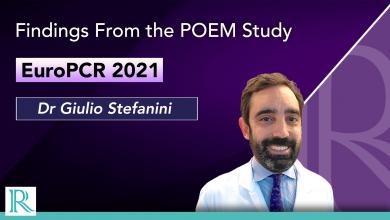Search results
Platinum Chromium Stent Series
Author(s):
Dominic J Allocco
,
Mary V Jacoski
,
Barbara Huibregtse
,
et al
Added:
3 years ago
Article
Author(s):
Giulio G Stefanini
Added:
2 years ago
Dr Giulio Stefanini (Humanitas Research Hospital, Milan, IT) discusses the findings from the multicentre POEM trial.The trial assessed the safety of the bioresorbable polymer-coated everolimus-eluting Synergy® stent in CAD patients undergoing PCI, followed by 1-month dual antiplatelet therapy (DAPT) in patients at high bleeding risk (HBR).
Questions:
1. What is the POEM Study and what does it…
View more
Bioresorbable Scaffolds
Author(s):
Sidakpal Panaich
,
Theodore Schreiber
,
Cindy Grines
Added:
3 years ago
Article
Author(s):
Kamal Chitkara
,
Anthony H Gershlick
Added:
3 years ago
First-generation Stents
Since drug-eluting stents (DES) received the CE mark in 2002 and the US Food and Drug Administration (FDA) approved the first DES in 2003, there has been a significant increase in the use of these devices. The advent of DES has revolutionised the field of interventional cardiology by having a major impact on patient care through their efficacy in reducing the need for…
View more
Author(s):
Roberto Diletti
,
Nicolas M Van Mieghem
Added:
3 years ago
Since Andreas Gruentzig presented his pioneering work in 1977, 'three revolutions' in percutaneous coronary interventions (PCI) have characterised the field of interventional cardiology. Plain old balloon angioplasty (POBA) was refined by the introduction of bare metal stenting (BMS) (second revolution) to address the issue of acute vessel recoil and unacceptably high rates of restenosis. Drug…
View more
Author(s):
Ehrin J Armstrong
,
Stephen W Waldo
Added:
3 years ago
Patients with diabetes mellitus (DM) have an increased prevalence of coronary artery disease (CAD) and are more likely to require coronary revascularisation than patients without DM.1 Similar to the general population, CAD remains the most frequent cause of death among patients with DM.2 As the prevalence of DM continues to rise worldwide, the appropriate management and method of…
View more
Author(s):
Thomas Pilgrim
Added:
5 years ago
Dr Thomas Pilgrim (University of Bern, CH) discusses BIOSCIENCE -Randomized comparison of an ultrathin cobaltchromium biodegradable polymer sirolimus-eluting stent with a thin strut durable polymer everolimus-eluting stent for PCI.
Filmed by Radcliffe Cardiology on site at ESC 2018, Munich.
View more
Author(s):
Robert A Byrne
,
Eric Eeckhout
,
Gennaro Sardella
,
et al
Added:
3 years ago
Percutaneous coronary intervention (PCI) and coronary artery bypass grafting (CABG) are established strategies for revascularisation in patients with coronary artery disease. While CABG was the standard of care for patients with multivessel disease, the introduction of baremetal stents (BMSs) and, later, drug-eluting stents (DESs) has led to an increased use of PCI in these more challenging cases…
View more
Author(s):
Nicolaus Reifart
,
Mariann Gyöngyösi
,
Karl-Eugen Hauptmann
,
et al
Added:
3 years ago
Coronary stent implantation is one of the most important developments in the field of percutaneous coronary revascularisation after the introduction of balloon angioplasty in 1977.1 The treatment of coronary artery disease (CAD) using a bare-metal stent (BMS) is considered effective; however, restenosis occurs in 15–35% of all cases, requiring repeated treatment.2–4 To overcome the restenosis…
View more
Author(s):
Michael Mæng
Added:
1 year ago
In this short interview, Dr Matthew Mæng (Aarhus University Hospital, DK) joins us to discuss the outcomes of a follow-up study on OCT SORT-OUT VIII (NCT02253108), originally presented at EuroPCR 2022.
This follow-up study aimed to compare the outcomes of Boston Scientific's SYNERGY™ stent to the BioMatrix NeoFlex stent.
Findings suggest that the SYNERGY™ stent was non-inferior to the BioMatrix…
View more













